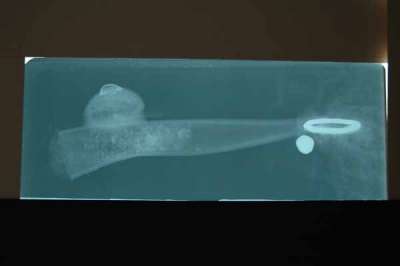Power bundle
A hand-written note by Dennett is tied into one of the cloth fronds of this nkisi. It informs the reader that this power figure was used for getting rich. Clasping the horn base are the tiny fingers of a potto (Perodicticus potto), a slow moving nocturnal primate.
Minkisi (sing. nkisi)
When Europeans first encountered power figures (minkisi) in the Congo, they believed them to be man-made deities (‘fetishes’) that were worshipped. However, minkisi belonged to an age-old complex cosmology, one that was centred on a reciprocating universe. This meant that there existed a constant interchange between the visible ‘world of the living’ and the invisible ‘world of the dead’. Minkisi created a physical connection between these worlds.
Their potency included ‘medicinal’ substances (bilongo) that would help to bind the powers of the invisible world to the figure. Bilongo included ingredients associated with the specific ability of the figure. They could be used to heal, alleviate hardship, locate witches or bring harm – they were mainly created for the benefit of people.
Minkisi were activated by a specialist called an nganga. Power figures were constructed with great care to produce a visual effect, they were viewed as items of great power. When not in use they were stored in the nganga’s hut.
Minkisi (sing. nkisi)
When Europeans first encountered power figures (minkisi) in the Congo, they believed them to be man-made deities (‘fetishes’) that were worshipped. However, minkisi belonged to an age-old complex cosmology, one that was centred on a reciprocating universe. This meant that there existed a constant interchange between the visible ‘world of the living’ and the invisible ‘world of the dead’. Minkisi created a physical connection between these worlds.
Their potency included ‘medicinal’ substances (bilongo) that would help to bind the powers of the invisible world to the figure. Bilongo included ingredients associated with the specific ability of the figure. They could be used to heal, alleviate hardship, locate witches or bring harm – they were mainly created for the benefit of people.
Minkisi were activated by a specialist called an nganga. Power figures were constructed with great care to produce a visual effect, they were viewed as items of great power. When not in use they were stored in the nganga’s hut.
Object Summary
- Accession Loan No.
- 9/1889/42
- Category
- Ethnography
- Collection Class
- Religion and magic
- Collection Area Region
- CENT
- Material
- clothhornfibre and grassshellgrass and feathers wood/horn
- Common Name
- power bundle
- Simple Name
- power figure
- Production County
- Kingdom of Kongo
- Production Country
- Congo, Democratic Republic of
- Production Year Low
- 1879
- Production Year High
- 1889


